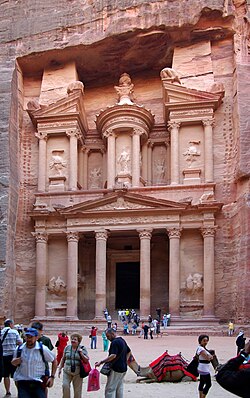Petra originally known as Raqmu, is a historical and archaeological city in southern Jordan. Petra lies on the slope of Jabal Al-Madbah in a basin among the mountains which form the eastern flank of Arabah valley that run from the Dead Sea to the Gulf of Aqaba. Petra is believed to have been settled as early as 9,000 BC, and it was possibly established in the 4th century BC as the capital city of the Nabataean Kingdom. The Nabataeans were nomadic Arabs who invested in Petra's proximity to the trade routes by establishing it as a major regional trading hub.
The trading business gained the Nabataeans considerable revenue and Petra became the focus of their wealth, drawing the envy of its neighbors. The earliest recorded historical reference to Petra was when the Greek Antigonids raided the city in 312 BC. The Nabataeans were, unlike their enemies, accustomed to living in the barren deserts, and were able to repel attacks by utilizing the area's mountainous terrain. They were particularly skillful in harvesting rainwater, agriculture and stone carving. Petra flourished in the 1st century AD when its famous Khazneh structure–believed to be the mausoleum of Nabataean King Aretas IV–was constructed, and its population peaked at an estimated 20,000 inhabitants.
The city of Petra is also known as the Pink City because of its stunning pink rocks. The city of Petra is visited by many tourists from all over the world, to witness the greatness of the building and the history of the ancient civilization that infects its explorers with utter astonishment.

City of Petra
The rock-cut city of Petra recounts immortal accounts that have not been able to pass through, and the most difficult circumstances, where the Nabataeans carved them to remain a witness to their ancient history.
Located in the south of Jordan, Petra is 225 kilometers away from the capital Amman, west of the main road between Amman and Aqaba.
The most important information about the city of Petra
It is one of the most important archaeological sites in Jordan.
The world is universally recognized as an unparalleled city, unparalleled in its legendary creativity with any other ancient city.
She won second place in the world competition of the Seven Wonders of the World.
Petra is a complete city carved in pink rock, from houses and streets, temples, palaces, shops, stables for horses and livestock, and others.
Petra is characterized by narrow corridors that prevent enemies from gaining access to it easily as a fortified fortress.
The Nabataeans built secret passages to get water without having to leave the city.
The Nabataeans built the city of Petra in 400 BC, making it their capital and the most important city of their kingdom until 106 AD.
Its borders extended from the coast of Ashkelon in Palestine to the west, to the desert of the Levant in the east, and from the north of Damascus to the Red Sea to the south.
The high technique followed by the Nabataeans in the careful selection of their city's location, which mediated the civilizations of Mesopotamia, the Levant, the Arabian Peninsula, and Egypt, made it an economic site that controls the business.
Commercial caravans from all over the country were loaded with spices and spices, incense from southern Arabia, silk from Gaza and Damascus, Henna from Ashkelon, glassware from Tire and Sidon, dates, pearls, gold and silver from the Arabian Gulf.
The roads were paved by convoys,
Near Mount Haroun, it is believed to include the tomb of the Prophet Harun (peace be upon him).
In Petra there are the seven springs that our master Moses threw with his stick of rock.
The most famous landmarks in Petra

Al Khazna is one of the most famous landmarks in Petra. It is accessible after passing through the archway, a narrow corridor between the high mountains, which barely allow the sun to pass through it, which adds a dramatic amount of mystery and magic to the next. The sun, and the width of the safe (28) meters, and the height (39.5) meters.
